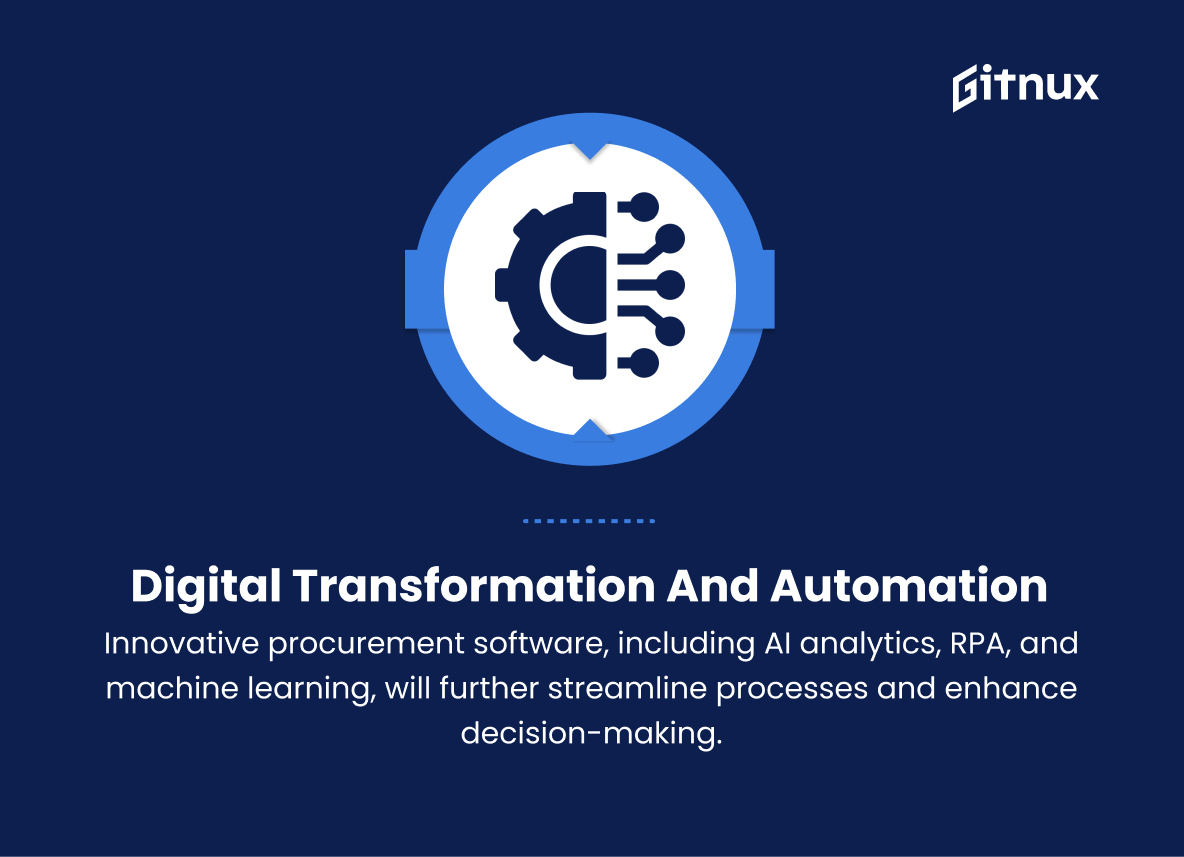Top Procurement Trends
In today’s rapidly evolving global marketplace, procurement has taken on an increasingly strategic role in shaping an organization’s competitive advantage and operational efficiency.
As a result, procurement leaders must stay informed on the latest trends, strategies, and technologies to ensure their organizations can effectively navigate these ever-changing waters.
In this thought-provoking blog post, we will dive deep into the most significant procurement trends that are shaping the way businesses function and make purchasing decisions.
From the growing influence of sustainability and digital transformation to the increased focus on supplier relationship management, our analysis will equip you with the insights to effectively adapt and optimally leverage your procurement processes for long-term success.
1. Digital transformation and automation
Innovative procurement software solutions, such as AI-driven analytics, robotic process automation (RPA), and machine learning algorithms will continue to streamline procurement processes and improve decision-making.
2. Sustainable procurement
Organizations are increasingly focusing on sustainable and ethical procurement practices to reduce their environmental impact, support local economies and ensure a socially responsible supply chain.
3. Supplier diversity and inclusion
Encouraging supplier diversity and inclusion is becoming a priority for businesses, ensuring procurement from minority-owned, woman-owned, and other underrepresented vendor groups.
4. Advanced data analytics
Data-driven insights are transforming procurement decision-making, helping organizations identify cost-saving opportunities, evaluate supplier performance, and optimize overall procurement strategies.
5. Strategic supplier relationship management
Businesses are moving towards more strategic and long-term relationships with their suppliers to foster collaboration, innovation, and mutual benefits.
6. Risk management and resilience
Procurement professionals are placing greater emphasis on risk assessment and mitigation to build more resilient supply chains that can withstand global political, economic, and environmental shocks.
7. Circular economy and waste reduction
There’s a growing focus on adopting circular economy principles and minimizing waste across the supply chain.
8. Blockchain technology
Distributed ledger technology (DLT), like blockchain, has the potential to enhance transparency, security, and traceability within procurement processes.
9. Flexibility and agility in sourcing
Procurement teams are increasingly adopting flexible and agile sourcing models to quickly adapt to changing market conditions and balance costs, risks, and value.
10. Skills development and upskilling
The evolving procurement landscape demands professionals with a broader skill set, including technological expertise, analytical capabilities, and soft skills like emotional intelligence and communication.
11. Crowdsourcing and open innovation
Organizations are tapping into external networks and communities to source ideas, products, and services, fostering innovation and collaboration in procurement.
12. Total cost of ownership (TCO) analysis
There’s a growing shift from focusing solely on the purchase price to considering the entire life cycle cost of a product or service, including maintenance, disposal, and environmental impact.
13. Tail spend management
Streamlining tail spend – typically the smallest, non-strategic purchases – can drive significant cost savings and efficiency improvements.
14. Geopolitical considerations
The ever-changing geopolitical landscape also impacts procurement strategies, as businesses need to assess potential risks and opportunities related to trade barriers, tariffs, and currency fluctuations.
15. Procurement as a service (PaaS)
Outsourcing certain procurement activities to specialized service providers can enhance flexibility and efficiency, allowing procurement teams to focus on more strategic initiatives.
Not all of these trends may be relevant to every organization, but they represent the diverse ways that procurement is evolving to create more efficient, resilient, and sustainable supply chains.
Implications
Digital transformation and automation are reshaping procurement through the use of innovative software solutions such as AI-driven analytics, robotic process automation, and machine learning algorithms that streamline processes and enhance decision-making.
At the same time, a growing emphasis on sustainable and ethical procurement practices is helping organizations reduce their environmental impact, support local economies, and foster socially responsible supply chains.
Supplier diversity and inclusion, advanced data analytics, and strategic supplier relationship management are also playing crucial roles in building more resilient and collaborative supply networks.
As a result, procurement professionals are focusing more on risk management, circular economy principles, and waste reduction, while harnessing emerging technologies like blockchain to bolster transparency and security.
To adapt to these trends, organizations are adopting flexible sourcing models, upskilling their workforce, and tapping into external networks through crowdsourcing and open innovation.
Furthermore, the growing importance of total cost of ownership analysis is pushing procurement teams to consider the entire life cycle of products and services, while managing tail spend for additional cost savings.
Geopolitical considerations are also becoming more critical in shaping procurement strategies, as organizations navigate trade barriers, tariffs, and currency fluctuations.
Lastly, the emergence of procurement as a service offers new opportunities for organizations to outsource specific procurement activities, allowing their teams to focus on more strategic initiatives.
These diverse trends collectively signal a future in which procurement becomes increasingly efficient, agile, and sustainable, fostering resilient and future-focused supply chains.
Conclusion
In summary, the ever-evolving landscape of procurement continues to witness significant trends, with technology and data-driven strategies at the forefront, shaping the future of procurement.
As businesses adapt to these changes, they must remain agile to stay competitive and leverage innovative solutions to realize the full potential of their procurement efforts.
By embracing digital transformation, fostering collaboration, promoting sustainability, and focusing on diversity and inclusion, companies can successfully navigate the challenges and seize the opportunities that lie ahead.
In doing so, they will not only elevate the role of procurement within their organization but also contribute to a future marked by responsible, ethical, and efficient global supply chain management.















